An Artist Pursuing Fiber Arts
Do you ever wonder what it’s like in the world of a fiber arts creative? Kathy from Horse n’ Round Studio was gracious enough to fill us in on what her journey to fiber artist, educator, vendor, and chainmail maker has been. Thinking outside the box and getting out there following a passion leads to adventures and trails to follow.
Tell us a little about yourself and what you are pursuing in fiber arts
Hi, I’m Kathy, and I’m a fiber addict. This isn’t far from the truth. As Horse ‘n’ Round Studio, I spin yarn, knit, crochet, weave, felt, and make chainmail. In my personal time, I also embroider, make historical and fantasy costumes, do some plastic canvas projects, and I’ve also recently picked up quilting again. Who doesn’t need more projects?
I am also a technical writer, editor, and graphic designer by trade, so I also publish designs and kits. This has also led me to teaching classes.

What was your journey to pursue this path?
It has definitely not been a straight path. I started embroidering, cross-stitching, and hand-sewing at a young age. At some point, my grandmother taught me to knit in the “throw” style, where you drop the righthand needle to throw the yarn around the tip and pick it up again to knit. This never clicked with me, and I eventually gave it up in favor of crocheting.

We couldn’t afford a lot of fancy kits or yarn, so when I ran out of whatever I received for holidays, I raided my mom’s fabric scraps and created strange little things, sometimes creatures that looked like the leper colony of the Island of Misfit Toys, sometimes Barbie clothes (well, body coverings at least), sometimes small quilt tops that became pillows. Anything to keep my hands busy and creative.
After graduating college, I continued cross-stitching, dabbling now and then with the cheap acrylic that was readily available. After several years, I joined a martial arts troupe called Seattle Knights, who specializes in choreographed combat and jousting. I met a whole new set of friends (including my future husband), started learning more about history than was ever covered in school, bought my first horse, and learned how to make chainmail.
Fast forward through an extended illness, a broken hand, getting engaged, travelling to England and Scotland, burning myself out at a corporate job, buying a second horse, and getting married.
In September of 2003, my husband Allan and I came up with Horse ‘n’ Round as an eventual farm name and started the business license. We tacked “Studio” at the end to signify a difference between the freelance tech writing/editing/graphic design/UI architecture business and the farm (eventually). At this time, we were still living in suburbia, but we had grandly casual plans.

Eventually, the technical freelancing fizzled and the chainmail and crocheting picked up more. I learned a lot of jewelry techniques in a not-so-part-time job at Ben Franklin in the bead department, and I learned continental style knitting, where everything suddenly made sense.
Throughout all of this, I started having health issues. There were stress-related skin issues, throat issues (potentially related to my previous extended illness), osteoarthritis, and a diabetes scare. I started examining the contents of everything, researching how things were made, what certain additives do, all of it. (No more diabetes, by the way!)
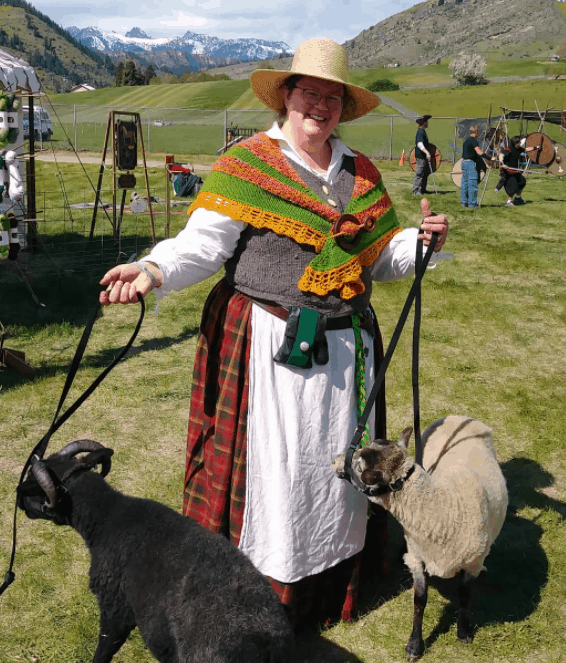
Because of this, I started spinning. Acrylic is terrible for the environment and rife with chemicals, especially those made here in the US. The wool market was still recovering from the UK’s outbreak of Hoof and Mouth Disease, where entire herds had to be wiped out. I wanted to support local farms, blend my own, all of it. By this time, we had moved out of town to a little 2/3-acre parcel. We got our first sheep, eventually got more, found a 5-acre place in Buckley, WA for our sheep and horses. This was the beginning of the Horse ‘n’ Round Studio you see today.
You deal with many types of fibers, cloth, and metal to create your fiber arts. Can you explain your favorites to work with and why?
I enjoy the history of a skill: why it was developed, how it was used, tools made that haven’t changed for a hundred years because modernization can’t improve on it.
Each type of fiber has its purpose. Like anyone, I love working with the soft stuff—merino, alpaca, silk—but it’s also fun working with more unusual fibers and finding the things they’re good at. For example, wool from one sheep may be coarse and difficult to work with initially, but if it gets knitted and felted, it becomes utterly luscious. Bouncy, curly fibers and imperfect yarns can be surprising and give a finished piece a wonderfully unique texture.
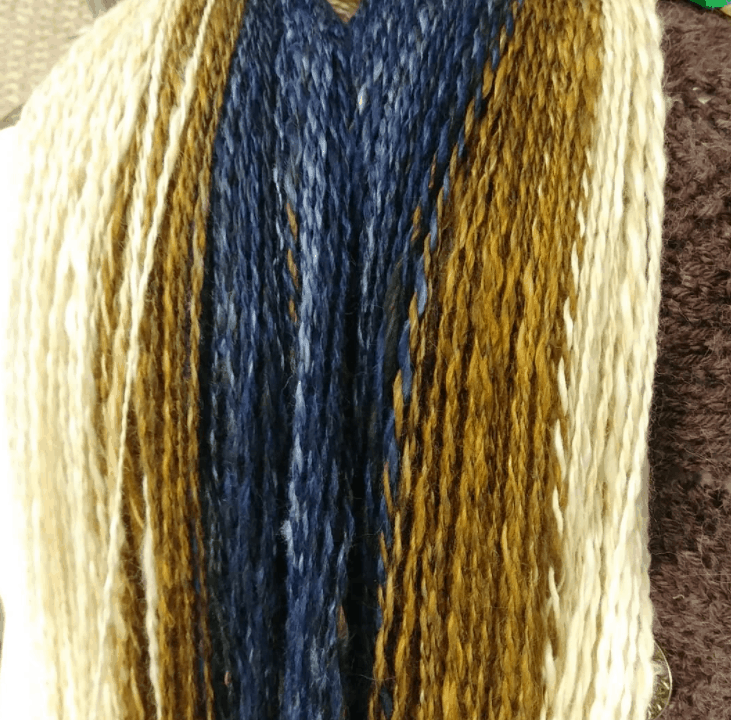
Some fibers dye better than others, or maybe take dye differently. In a skein of mixed fibers, like wool and silk, you can end up with some amazing effects of color and shine.
Overall, my favorites to work with are natural wools, even if they have been dyed over a natural color. They are inconsistent by nature, but the depth of color cannot be matched by dye alone.
As you might guess, working with modern machines like a sewing machine aren’t my favorite, and sometimes we don’t get along, but sometimes it’s necessary. I’m re-learning to like it, but it’s slow going with the limited amount of time I have to devote to it.
I see that you construct chain mail. How do you determine the right shape or design for the customer?
Measurements! For historical styles, as any costumer can tell you, the proportions are the most important. For men, the measurements tend to be a little easier, as the main measurements that matter are around the shoulders, around the head, including the nose (so they can get the shirt on), and length.
The shaping is done through increases and decreases and gussets, and the measurements taken define the minimum size the shirt can go. You also can’t let it get too baggy, like the cheaply made, one-size-fits-all shirts from overseas, because it will catch on everything, it’s more weight than you need, and you’ll end up repairing it as often as you wear it.
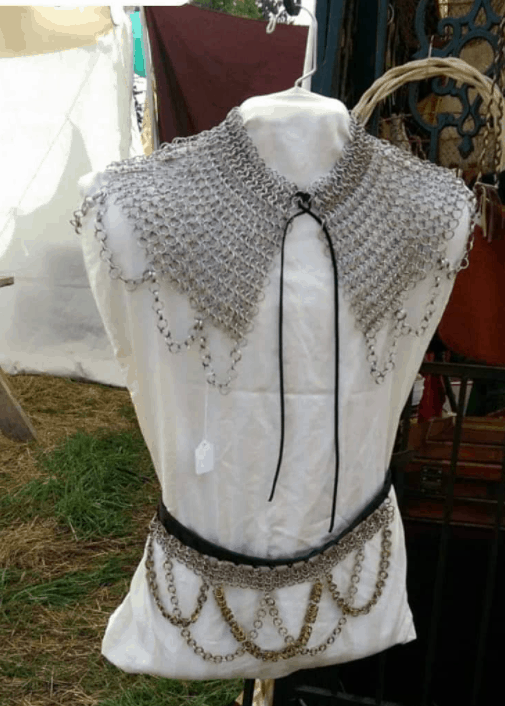
Women can be a little harder to measure for, because we tend to have more curves, though a good belt is priceless for defining the waist. We also don’t have a lot of historical representations of women in armor (though we know it happened), so it becomes a sort of practical archaeology. What works and what doesn’t, adjusting for body type and fitting needs.
But for fantasy pieces, leather lacing and mixed panels and colorized rings make the options nearly limitless.
Can you describe a bit about your experiences in Seattle Knights and other re-enactment arenas?
So many stories. The basic thing is that even though it is (mostly) choreographed fighting, Seattle Knights is still teaching western martial arts. As you go through all the levels of classes, you are still learning historical concepts of how to hurt people so you know how NOT to hurt your fight partner.
You learn how to carry yourself so you don’t die in 100-degree heat wearing armor. You also learn how to answer questions people will ask between shows, how to create a character, how to improvise when something doesn’t go to plan (both good and bad). Everyone looks after each other, keeping everyone safe. It’s really an amazing experience to have friends you swing steel with because of the intense amount of trust you need to develop in each other.
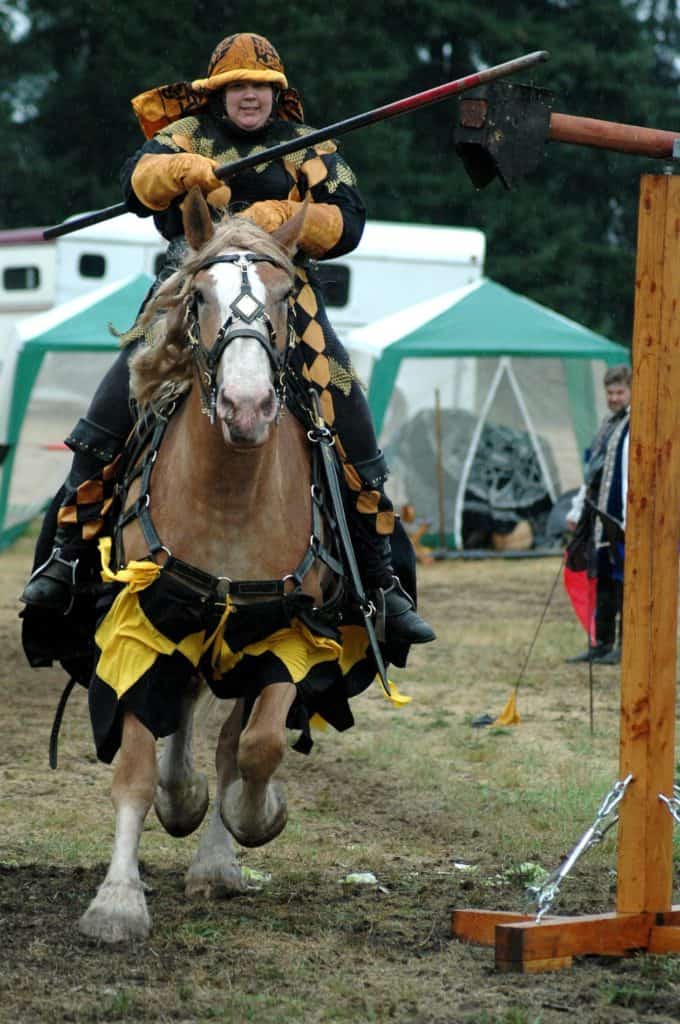
Of course, accidents do happen.
My famous story is that I stabbed Allan, so he married me. He was one of the teachers’ assistants in the class where I was learning how to choreograph a fight with a dagger. I accidentally pricked him a couple of times, emailed him later in the week to apologize, and we started dating that weekend.
The other story I tell when talking about the efficacy of chainmail is that wearing chainmail saved my kidney. I had a fight in a show where my opponent, Tracy, was supposed to knock me down, then kneel beside me and force me to yield. When it came time to perform this, the area was a strange layout on a hillside, and when Tracy knocked me down, I accidentally fell on one of the stakes holding down the jousting lines.
I arched my back to keep the weight off, but then Tracy stumbled and actually landed with her knee on my stomach instead of the ground beside me. With the added impact, the stake punched through my armor. I yielded readily, of course, and managed to push Tracy off of me, still in character. (Part of the learn improv skills, despite the pain.)
Someone from my own team helped detach me from the stake and the medic and I disappeared quietly into a tent as the show continued, no one the wiser. I had a hefty bruise and small abrasion, but no internal damage. I just can’t sit for long periods of time with anything pressing on that area (which is why I don’t wear corsets or stays as a merchant now).
What is your favorite type of vending event? What makes it enjoyable, successful, satisfying?
After 2020, and looking at probably not doing many shows until the fall of 2021, the shows I miss most are camping shows! I merchant at both Renaissance Faires and reenactment events with the Society for Creative Anachronism (SCA) and a few mountain man era events, like Women’s Primitive Skills. Nothing compares with cooking over a campstove, those quiet early-morning hours as the camp wakes up, and cuddling into a sleeping back with sheep munching happily nearby.

You offer educational articles and workshops, what would be some advice to someone who has similar interests and is looking into vending events?
Just do it! It depends heavily on what type of thing you want to sell and what type of event you want to do. However, the main thing is to read the rules, ask questions, respect the coordinator, respect your fellow vendors, make friends with your neighbors, arrive on time, never leave early, and cover the junk under your table. (For more info. you can read Kathy’s article series on vending)
Do you have plans to expand your farm, animals, products, goals for future?
I would like to get more sheep. I’d also like to have horses again. And once the pandemic is a little more under control, I’d like to get back to hosting public craft nights and doing shows again, though maybe not at the rate of 20 shows a year like I used to.


I have a few ideas for future products, but we’ll see how things pan out. I’ve been under a mountain of commissions for so long, but I see the light at the end of the tunnel. Once I finish those, I’d like to work on rebuilding stock but also play with some new ideas for products that I’m not seeing offered anywhere yet.
In the meantime, I’ve been building up the blog and trying to get a YouTube channel started with the limited time left between everything else. It’s a crazy adventure, and I like to keep an open mind about what the future may hold!
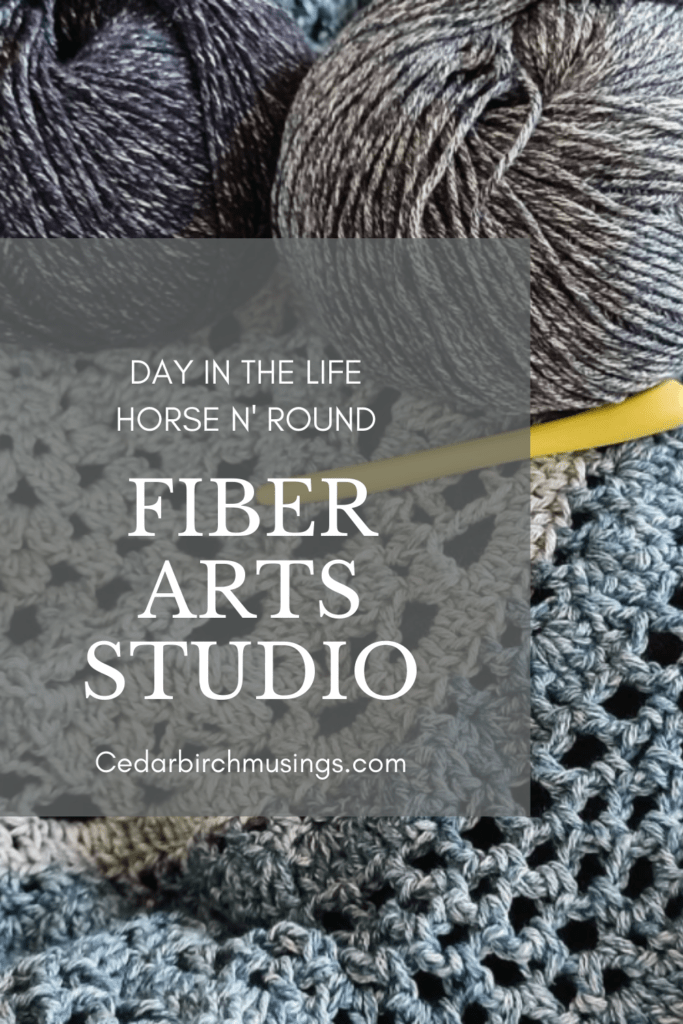

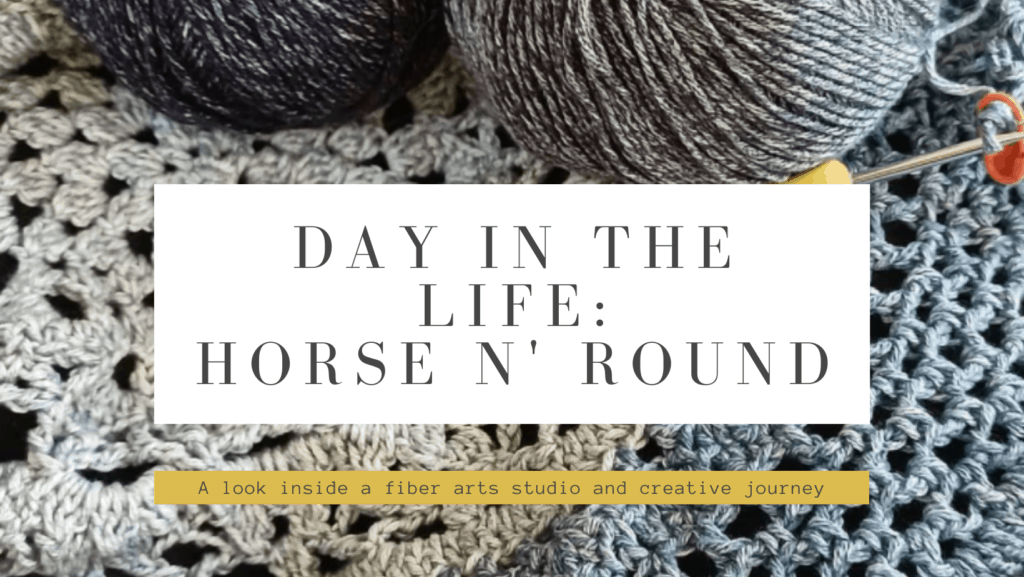

this is something I really wanted to try, it takes a lot of creativity and imagination to come up with a unique output.
Totally! Kathy is very inspiring– I may have to drag out my crochet hooks again;)